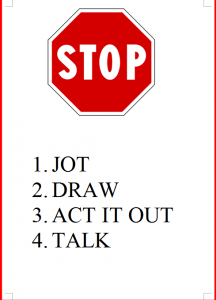After my workshop last week, learning how utilizing summarizing techniques WHILE instructing and teaching can impact learning—I decided to investigate further! Note: Summarizing ranks 2nd in the top 5 list for most effective instructional strategies that impact students.
Remember it is not about writing a summary but having students engaged in thinking, writing, and actively summarizing their learning DURING instruction. When learning a topic, your student goes through four levels of thinking to attain mastery. Learning begins with awareness of the topic and moves to knowledge. With a knowledge base, students must be given the opportunity to apply learning and begin the opportunity to understand or use the skill. When application is mastered then students have the ability to understand or use the skill to mastery. By stopping throughout the lesson to review and synthesize information, students have the opportunity to build on one level of thinking and begin moving to the next. A teacher can then provide another layer of information, graphics, questions, or scaffolding for students to continue deepening their learning.
Three strategies to encourage reflective thinking and infuse summarizing in lessons ALL day!
- Quick Writes: Allow students opportunity to stop and write words, phrases or sentences on a topic you are learning. For example, you have just taught about the water cycle.
- Stop and allow students to write for 3 minutes and show you everything they know about what they have learned. No worries about spelling or conventions.
- Pair this strategy by allowing them to partner with another student to share their ideas and learning. This deepens their learning by allowing them to begin applying the academic language they have learned.
- Draw It! Yes it is that simple! Just like a quick write but instead of writing—they draw. The important step for drawing out their ideas is that after they have finished drawing—they have to label it. This begins students associating their own thinking with the academic vocabulary you are teaching.
- As an extension you can require students to include certain vocabulary.
- Have students continue to add to their drawing as they learn more and discuss with a partner what additions they added or changes they made and why!
- Create a Simile: After you have discussed a vocabulary term or topic, have students create a simile to make a comparison to the word or idea to something similar to their lives. This type of thinking helps students take an abstract idea and make it concrete in their own terms.
- Use a sentence frame to help students get started such as meteors are like__________________ because ______________.
- Have students share out similes and continue to refine your discussion and explanation until students begin to deepen thinking of the idea.
Having students reflect on their thinking is not a new concept and neither is writing a summary. However, by having students applying reflection and summarizing throughout a lesson, you are deepening their ideas on a concept. Remember when talking, drawing, writing and interacting with information—students are building conceptual understanding!
Articles considered when writing this Blog:
http://www.learningfocused.com/tips-for-using-distributed-summarizing-with-higher-order-thinking/
http://www.hawaii.edu/intlrel/pols382/Reflective%20Thinking%20-%20UH/reflection.html
